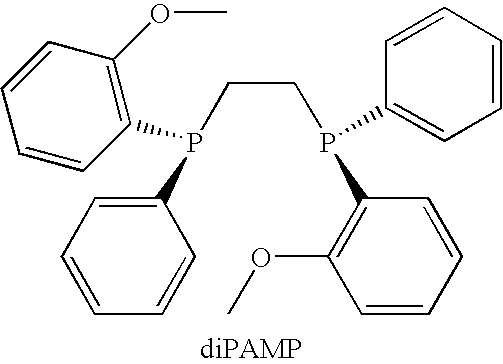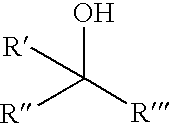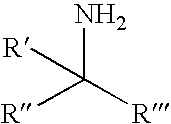Chiral Phosphorus Compounds
a phosphorus compound and phosphorus technology, applied in the field of chiral phosphorus compounds, can solve the problems of large effort, limited route, and general application method, and achieve the effects of high yield, confirming enantioselectivity, and influencing reaction selectivity
- Summary
- Abstract
- Description
- Claims
- Application Information
AI Technical Summary
Benefits of technology
Problems solved by technology
Method used
Image
Examples
example 1
Materials and Methods
Analysis of Enantiomeric Excesses
[0110]The product four coordinated phosphorus compounds were analysed by high performance liquid chromatography on chiral stationary phases (CSP-HPLC). Typically, a 25 μL sample of the reaction mixture was injected onto the HPLC column.
[0111]Tert-Butylmethyl(diphenylamino)phosphine oxide (tBuMePNPh2) was analysed on a CHIRALPAK AS-H column 25 cm×0.46 cm I.D., with pentane / ethanol (98:2) as the mobile phase and a flow rate of 0.7 mL / min with the UV detector operating at 254 nm. This gave retention times of 20 and 37 minutes for racemic phosphine oxide.
[0112]tert-Butylcyclohexylbenzylphosphine oxide was analysed on a CHIRALPAK AS-H column 25 cm×0.46 cm I.D., with n-heptane / 2-propanol (99.5:0.5) as the mobile phase and a flow rate of 0.5 mL / min with the UV detector operating at 235 nm. This gave retention times of 9 and 9.9 minutes for racemic phosphine oxide.
[0113]o-Anisylphenylo-tolylphosphine oxide was analysed on a CHIRALPAK AD ...
example 2
Representative Reactions
Representative Procedure A: Using Carbon Tetrachloride as Solvent at Reflux
[0124]A 5 mL round bottom flask equipped with stirring bar, reflux condenser and nitrogen inlet / outlet was charged with PAMP (1 equiv, 25 mg, 0.11 mmol), chiral alcohol (1.2 equiv, 0.13 mmol) and carbon tetrachloride (3 mL). The reaction was refluxed for 24 hours. A sample was then directly removed for HPLC analysis.
Representative Procedure B: Using 1 Eqv. Carbon Tetrachloride in Solvent at Reflux
[0125]A 5 mL round bottom flask equipped with stirring bar, reflux condenser and nitrogen inlet / outlet was charged with PAMP (1 equiv, 25 mg, 0.11 mmol), chiral alcohol (1.2 equiv, 0.13 mmol) and the required solvent (3 mL). The solution was stirred and to this carbon tetrachloride (1 equiv, 9.6 microlitres, 0.11 mmol) was added. The reaction was refluxed and on completion a sample was directly removed for HPLC analysis.
Representative Procedure C: Using Hexachloroacetone (HCA) in Benzene at Ro...
example 3
Effect of Different Chiral Alcohols Using Procedure A
[0128]A series of chiral non-racemic terpineols structurally related to menthol was then examined to determine their influence on reaction selectivity. In all cases reactions were performed in carbon tetrachloride at reflux with 1:1 PAMP / alcohol stoichiometry using representative procedure A. The results are shown in Table 1.
TABLE 1ChiraleeYieldConfigurationEntryAlcohol(%)(%)of P═O1 (−) Menthol2465R2 (−) 8-Phenylmenthol5366R3 (−) trans-2-Phenylcyclohexanol1980R4 (+) Fenchyl alcohol2382S1 Fructose derivative1628S2(1R,2S)-(−)-Cyclohexandiol1868R
PUM
 Login to View More
Login to View More Abstract
Description
Claims
Application Information
 Login to View More
Login to View More - R&D
- Intellectual Property
- Life Sciences
- Materials
- Tech Scout
- Unparalleled Data Quality
- Higher Quality Content
- 60% Fewer Hallucinations
Browse by: Latest US Patents, China's latest patents, Technical Efficacy Thesaurus, Application Domain, Technology Topic, Popular Technical Reports.
© 2025 PatSnap. All rights reserved.Legal|Privacy policy|Modern Slavery Act Transparency Statement|Sitemap|About US| Contact US: help@patsnap.com



